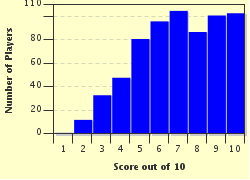Quiz Answer Key and Fun Facts
1. I am found in nature as a colorless, odorless monatomic gas who is a little bit lost. I thought my family name was 'inert gas', but I couldn't find them listed in the directory. I am also confused about the number of our address - the sign said 0 when I was visiting an English cousin, but VIIIA when I saw Uncle Neon's show in Las Vegas. Last week Aunt Argon told me we reside at Number 18. Can you tell me the name now used for my chemical family?
2. I am a soft, ductile silvery-white metal, although I sometimes develop a goldish sheen when exposed to traces of oxygen. This crazy yellow-green gas keeps trying to hook up with me, saying we will make a tasty couple. I think she has me confused with one of the lighter members of my family, because all except one of my isotopes are radioactive, and I somehow doubt that people would want to put any compound made from me on their food. I do like company, however, and have been known to set myself on fire with excitement when exposed to air. And don't get me started with water! What is the name usually used for my chemical family?
3. My friends and I are usually shown separately from the rest of the Periodic Table - those snobby elements just won't make room for us to join their little clique, although we would fit in quite nicely between radium and rutherfordium. I'll admit that we are all radioactive, but so are some of them. And just because some of us are the critical elements for producing nuclear weapons is no reason to ostracize us all! After all, we are also used for smoke detectors, which save lives when properly installed and maintained. So what is the IUPAC-approved name for us?
4. Our family is named after its lightest member, who forms over three quarters of the Earth's atmosphere. The rest of us are not convinced this is fair, since in his elemental form he doesn't really do much. The rest of us are far more solid citizens, and much more deserving of the honor of having the group named after us. Which chemical group are we?
5. I wish the rest of my family were still happy to identify me for our group name. In the good old days, they were happy to acknowledge my importance as one of the essentials for sustaining life, not only as a diatomic molecule that forms about one fifth of the Earth's atmosphere but also as a triatomic molecule that protects the Earth's surface from harmful radiation, and as one of the two elements that forms water. But we are no longer called the oxygen family - what name is now used for us?
6. Cerium's the name, forming ores is my game. I am the 25th most abundant element in the Earth's crust, but you'd never guess that from my family name. My closest friends are the other lanthanoids, but we have two smaller friends who are often referred to, along with us, by which of these names?
7. I don't feel as if I quite fit in to any category. I am often shown on top of Group 1, but with a gap so that I am not connected to the others. Sometimes I am shown floating in the middle of the Periodic Table, not joining any of the other elements. Then again, I can be shown lurking at the top of Group 17, but still not linked up. You would think that the most abundant element in the universe would be welcome to join any group, but not so! Who am I, the only element with no clear family in the IUPAC system?
8. Maggie and Cal here, reporting on the group 2 elements, which are sometimes called the beryllium family, after the lightest member of the group. By what name are we also called, referring to the fact that we react with water to form solutions with a high pH?
9. Okay, we don't get a single number allocated by which we can identify ourselves. We live in the same neighborhood of the Periodic Table, and like to consider ourselves as a stairway connecting the opposing sides in the game of the elements. What name is given to this informal grouping of elements which display a mixture of metallic and non-metallic properties?
10. Ours is the only group on the periodic table to include all three states of matter when you see us at room temperature. We have two gasses, one liquid and two solids sitting around the table for family meals. While we would like a name that relates to us on our own, we actually use one that describes what happens when we react with metals. Which family, found in group 17, are we?
Source: Author
looney_tunes
This quiz was reviewed by FunTrivia editor
WesleyCrusher before going online.
Any errors found in FunTrivia content are routinely corrected through our feedback system.

